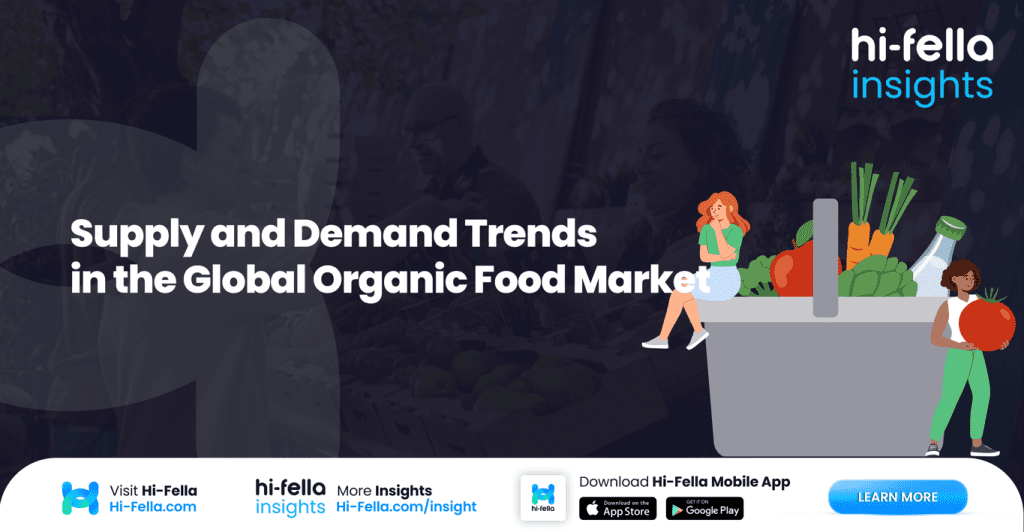The global organic food market has been experiencing remarkable growth, driven by a confluence of health consciousness, environmental awareness, and shifting consumer preferences. Let’s delve into the intricate dance of supply and demand that shapes this burgeoning industry.
The Surge in Demand: Health Meets Sustainability
In recent years, consumers have been making more conscious decisions about what ends up on their plates—and more importantly, why. The demand for organic food is no longer confined to niche health food stores or wellness influencers. It’s now a global consumer movement, driven by a convergence of personal health concerns, environmental anxiety, and social identity. People aren’t just eating to nourish their bodies; they’re voting with their forks. Choosing organic is a powerful way to signal a commitment to clean eating and eco-conscious living.
The perception of organic food as a healthier, safer alternative plays a massive role in this rising demand. Organic produce is commonly associated with being free of harmful synthetic chemicals like pesticides and herbicides, and many believe it contains higher nutrient content. Whether or not the science always backs those claims, the perception has already shaped behaviour. Organic labels have become shorthand for “better-for-you,” especially in affluent markets like the US, UK, and parts of Asia, where health and longevity are deeply ingrained cultural values.
But the shift isn’t just about health—it’s also about sustainability. Climate change, deforestation, and soil degradation have made people increasingly sensitive to the environmental impact of industrial agriculture. Organic farming, by contrast, is often seen as a more sustainable method, supporting soil health, biodiversity, and lower carbon emissions. Millennials and Gen Z, in particular, are driving this change, as they tend to care not only about what food is made of but how it’s made and sourced. These generations are fuelling demand with their wallets, and the market is responding.
The numbers tell a powerful story. In 2023, the global organic food market was already worth over USD 204 billion. But that’s just the beginning—by 2034, it’s projected to hit USD 658 billion, according to recent industry forecasts. That’s an 11.17% compound annual growth rate (CAGR), which is seriously impressive in the food and beverage space. Zooming into regional markets, the United States alone is expected to more than double its organic food market size by 2033, reaching around USD 159 billion, while Europe, a consistent champion of sustainable agriculture, held 44.17% of the global market share in 2023. That level of market maturity and potential makes organic food a trend that’s not just growing—it’s here to stay.
What’s really interesting is that this demand isn’t driven solely by consumers anymore. Big retailers, restaurants, and even fast food chains are catching on. You’ve got chains like Whole Foods, Trader Joe’s, and even McDonald’s Europe introducing organic product lines. Supply is being reshaped because demand has become impossible to ignore. When the market speaks this loudly—driven by lifestyle, values, and long-term health thinking—the entire food ecosystem listens.
Supply Challenges: Keeping Up with the Green Wave
As consumer awareness about health, sustainability, and food safety grows, the demand for organic products is surging across global markets. However, meeting this expanding demand is not without its hurdles. The organic supply chain faces several structural and operational challenges that hinder its scalability and efficiency.
Agricultural Constraints
One of the most fundamental barriers lies in the transition from conventional to organic agriculture. Unlike conventional farming, which can adapt more rapidly to market demands, organic farming requires a conversion period—typically three years—to cleanse the soil of chemical residues and comply with organic certification standards. This delay creates a time lag in increasing certified organic farmland.
Additionally, organic farming prohibits synthetic fertilizers and pesticides, making pest control and nutrient management more complex. Farmers often rely on crop rotation, composting, and natural pest deterrents, which can be less predictable and more labour-intensive. In regions where climate variability is high or soil fertility is poor, adopting organic methods without significant support can result in lower productivity and deter farmers from making the switch.
Higher Production Costs
Organic farming is inherently more expensive. Without the use of synthetic chemicals, farmers must invest more time and labour in managing crops. Manual weeding, natural pest control measures, and organic feed for livestock all contribute to higher operational costs. Furthermore, organic farming often yields less per acre compared to conventional farming, particularly in the early years of transition.
These increased costs are typically passed on to the end consumer. As a result, organic food prices are often significantly higher, which can make them inaccessible to middle- and lower-income consumers. This cost barrier limits the potential market size and makes it challenging for organic brands to achieve economies of scale.
Supply Chain Complexities
The journey of organic produce from farm to table must be tightly regulated to maintain its certification status. Every stage of the supply chain—including harvesting, processing, transportation, and storage—must adhere to organic protocols and undergo certification.
Cross-contamination risks are a constant concern. For example, a truck that previously transported conventional grain must be thoroughly cleaned before carrying organic produce to prevent contamination. These precautions add to logistical costs and require meticulous planning.
Moreover, the global nature of organic trade—where ingredients are often sourced from different countries—further complicates traceability and certification compliance. Without robust and transparent supply chain systems, the risk of fraud or mislabelling increases, threatening consumer trust in the organic label.
Bridging the Gap: Innovations and Strategies
Despite the challenges, stakeholders across the organic ecosystem are actively pursuing innovative strategies to overcome supply-side limitations and build a more resilient organic market. From high-tech farming solutions to government policy interventions, multiple avenues are being explored.
Technological Advancements
Modern agricultural technologies offer promising solutions to scale up organic production without compromising on sustainability. For instance:
- Vertical Farming: By growing crops in stacked layers using controlled environments, vertical farming can significantly reduce land usage and eliminate the need for chemical pesticides. Although still in its early stages for organics, vertical farming shows promise for leafy greens and herbs.
- Hydroponics and Aquaponics: These soilless farming methods can produce crops using less water and space. While some certification bodies debate whether hydroponically grown food qualifies as organic, the method is gaining traction for its efficiency and year-round production potential.
- Precision Agriculture: Tools like drones, AI-based monitoring systems, and data analytics can help organic farmers optimise resource use, manage pests naturally, and increase yields without violating organic standards.
Policy Support
Recognising the long-term benefits of organic farming for health and the environment, many governments and international organisations are stepping in with targeted support:
- Subsidies and Grants: Financial incentives help offset the costs of certification, training, and the initial lower yields during the transition phase.
- Educational Programmes: Extension services and training initiatives help farmers adopt organic techniques more effectively, increasing success rates and confidence in organic agriculture.
- Land Conversion Support: In countries like India, Germany, and France, special programmes assist in converting conventional land into organic-certified farmland by providing technical and financial aid.
Supply Chain Optimization
To address the complexity of organic supply chains, companies are investing in smart logistics and transparent sourcing models:
- Blockchain Technology: By leveraging blockchain, stakeholders can create immutable records of product journeys, ensuring traceability from farm to shelf and enhancing consumer confidence.
- Integrated Logistics Solutions: Cold chain management and cooperative distribution networks are being developed to reduce spoilage and streamline organic product movement.
- Direct-to-Consumer (DTC) Models: Organic brands are also bypassing traditional retail models and connecting directly with consumers through online platforms and subscription-based deliveries, which can reduce distribution costs and improve margins.
In essence, bridging the gap between organic demand and supply requires a multifaceted approach—combining innovation, supportive policy, and efficient logistics. While the journey is complex, the momentum behind the green wave continues to build, and with the right support systems in place, a more sustainable and scalable organic future is within reach.
The Road Ahead: A Balanced Growth
The global organic food market stands at a pivotal juncture. While demand continues to soar, the supply side must innovate and adapt to keep pace. Collaborative efforts among farmers, policymakers, and industry players are essential to ensure that the organic food market not only grows but does so sustainably and equitably.
Understanding these supply and demand dynamics offers valuable insights into the future trajectory of the organic food industry, highlighting both the opportunities and challenges that lie ahead.
Connecting the Dots: Join Hi-Fella and Be Part of the Organic Solution
As the organic movement continues to gain traction globally, the need for effective collaboration between stakeholders has never been more critical. Producers face mounting challenges in scaling up supply, while buyers and retailers strive to meet the growing expectations of health-conscious consumers. What’s needed is a bridge—a smart, reliable platform where both sides can connect, collaborate, and grow together.
Hi-Fella is that bridge.
Hi-Fella is an innovative platform designed to bring together suppliers, buyers, and industry players in one digital ecosystem. Whether you’re an organic farmer looking to expand your market reach or a retailer sourcing certified organic products, Hi-Fella offers the tools and connections to make it happen. With a focus on trust, traceability, and transparency, the platform empowers participants to streamline transactions, build lasting partnerships, and stay ahead in a competitive market








